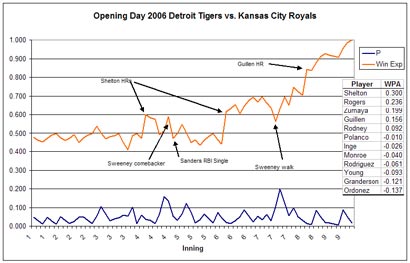Yesterday you got my emotional and giddy breakdown of Opening Day. Today I’ll take a look at the game, but from a much more analytical perspective.
For those that read the Hardball Times on a regular basis last season, you may recall Dave Studemund writing about Win Probability Added. That preceding link has a very nice explanation that if you are intrigued I highly recommend reading. If you want the cliff-note version I’ll give it a shot here.
At any point in a game, one can look at a situation and determine what the odds are of a team winning. By situation I mean inning, run differential, and base-out state. We can do this because there is lots and lots of data to look back on. If we know the probability for all of these situations or game states, we can then determine each players contribution in terms of helping (or hurting) his team’s chances of winning. This contribution is defined as the change in probability as the game progresses from one state to the next. For example, if a batter were to hit a solo home run to put his team up by a run, he would increase his team’s chances by X%, and the opposing pitcher would decrease his team’s chances of winning by the same amount.
While the system isn’t really designed to measure talent, it does help to measure importance. This is especially true for relief pitcher situations.
Studemund created a spreadsheet so that you (in this case me) can play along at home and track WPA throughout a game. Inspired by the folks at Beyond The Boxscore, I decided to track the Opening Day game on Monday.
The chart below shows 1)the Tigers probability of winning as the game progressed and 2)the criticality (P) of different points in the game.

Now unforutnately, this game proved to be pretty boring game to try this exercise. There weren’t many swings back and forth. And there weren’t even that many situations where one team was really threatening.
Kenny Rogers biggest play came when he induced Sweeney into a comebacker with the tying run on third base and one out. It was also the most critical situation he faced. (In terms of P, a value greater than .2 is considered important and a value greater than .3 is considered critical)
Joel Zumaya pitched in the most critical moment of the game, but it was a situation he put himself in by walking Sweeney. It ended up being a non-event as he struck out the next two hitters.
The biggest play of the game for either team was Chris Shelton’s sixth inning home run. It game the Tigers the lead, and carried more weight than Shelton’s 4th inning jack because it game the Royals less time to come back.
The table indicates the cumulative WPA for each of the Tiger players. Not surprisingly Shelton, Rogers, Zumaya and Guillen led the way. But as I mentioned earlier, this game was pretty vanilla and so I wouldn’t expect to see any great insights here.
In the end it was a fun exercise. It didn’t tell us very much in this particular case, but it is something I plan on doing again this season. I’m mostly interested in seeing how Jim Leyland decides to deploy his bullpen. I’m also interested in tracking who gets the important hits, and who is just piling on in a blow out.
You know what would be fun… To go back and run this for an entire season of the Tony Clark-Damion Easley-Bobby Higginson era Tigers. I always had a suspicion that Tony Clark hit better in games that were well in hand. What it wouldn’t measure, though, was my observation that Tony always started hitting better after we were 10 games out of first place.
For what it’s worth, I think I’m going to try to track WPA for the every Tigers game this season and toss a little report up on the blog linked by my name. i just made this decision yesterday, so i think i’ll hold off on doing opening day since you did it 😉
I tell you what, I did it for yesterday’s game, mainly because it was a day game and I was at work… I think I’m going to be just *that much* less efficient at my job this summer…. It was a damn lot of fun, watching that win probability go up and up… Went over .950 with Pudge’s 2-run shot that made it 6-0… I thought it was pretty early yet to declare the game all-but-over, not that I’m arguing with the results.